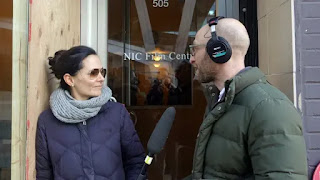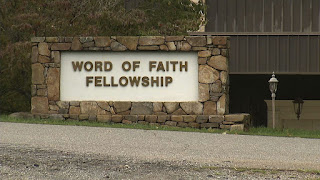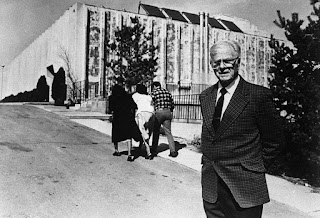 |
| Josh Bloch interviews Sarah Edmondson |
CBC Radio
May 31, 2018
An Albany-based organization that calls itself a self-help group is accused of being a cult. One former member describes being branded with a hot cauterizing device, searing the initials of the group's leader permanently into her flesh.
Arrests are made. Charges are laid. People implicated include a hypnotist, the millionaire heiresses to a liquor dynasty and a few Hollywood stars.
CBC's podcast Uncover: Escaping NXIVM peels back the layers of this organization, focusing on key figures in the group's history while documenting one woman's quest to free herself from its grasp.
CBC Radio spoke with co-producers Josh Bloch and Kathleen Goldhar about the chance meeting that sparked the podcast in the first place, and what groups like NXIVM have in common with other controversial or cult-like organizations — from their recruitment tactics to the polarizing personalities at their head.
JB: The podcast is about this organization called NXIVM, which fronts as a self-help group, as a humanitarian program, and that has been accused by some people that have left of being a cult – of using the self-help aspect of the organization to groom women to sleep with the leader [Keith Raniere].
How did the idea for the podcast start?
I ended up running into an old friend of mine [Sarah Edmondson] in Vancouver, who had just left the organization. It was August [2017], she had literally just left about two months before that, and was considering going to the media about her experience.
She had been in it for 12 years. She was running their Vancouver offices. She was their star recruiter. And it was a crazy story she was telling me.
The more I looked into it, the crazier the story was.- Josh Bloch, host
The more I looked into it, the crazier the story was. I initially thought, oh, this would be a fascinating interview for The Current or maybe a documentary. [But] it just was too big. It was too hard to imagine how you would tell the story in just 20 minutes, and that's how the podcast came about.
KG: Except you missed one really important detail.
JB: Which was what?
KG: That she told you she got branded.
JB: Right. Yes.
KG: She had been thinking she was joining a women's only support and empowerment group [called DOS, or "dominant over submissive"] within the group. She thought she was going to have a ceremony where she was going to get a tattoo that would sort of tie them all together.
It ended up that she got held down and branded. Then she found out that she was branded with the leader's initials – Keith Raniere – and with the Smallville actress's initials – Allison Mack.
What can people expect when they listen to this podcast?
KG: Well, the story has been in the news. So everyone at this point sort of knows the name Keith Raniere, and knows about the branding.
Arrest of alleged cult leader 'better than my wedding day,' former NXIVM member says
What we do differently, which is what podcasts can do, is bring you into that story like you have never heard or read before. So for the first episode, we literally put you on the table with Sarah while [the branding] is happening.
The other thing that we do is help you understand, through understanding their teachings and their philosophies, [is] how Sarah, this seemingly normal educated reasonable woman, could get to the point where she's lying on a table getting cauterized and burned. And [how] even in that moment thinks this is something she needs to do.
What we do differently, which is what podcasts can do, is bring you into that story like you have never heard or read before.- Kathleen Goldhar, producer
We also do a deep dive into their leader, Keith Raniere. We go to his neighborhood where he grew up; we talk to old friends, we talk to old girlfriends, we talk to people who have left him but have a lot of insights into him, and — as best we can for somebody who's kept very quiet about who he is — try to figure out his true motivations.
And we also introduce you to people that have so far felt tangential to the story. We bring them in and explain how important they are, including people like Clare and Sara Bronfman, who were heiresses to the [Seagram liquor] fortune, who are funding NXIVM.
There's been a long-time fascination with cults or cult-like organizations, especially those that have some kind of Hollywood connection. Were there any similarities in the NXIVM story to other well-known cult stories?
JB: One of the things as we were digging into, and talking to experts about, is you realize how they all have pretty much the same playbook. They all do similar kinds of things in order to recruit people and to get people involved and to make it difficult to leave and to isolate people that go there.
One of the things they did very well was create a really powerful hook. For whatever messed-up things happened in the higher levels of the organization, we've talked to dozens of people who took their entry-level courses … and almost everyone says they loved them. They're really good, they were stimulating, we got a lot out of them, and we had these breakthroughs, etc.
They had that self-help side … They had this idea of executive success and really wanted to attract people who were successful and give off this air of, "become part of this organization because you can be as successful and beautiful as everyone in this community." They put a lot of value on money and physical looks.
Over the last few months, arrests were made and charges were laid. How did that change the podcast as you were developing it? Did it make things easier or harder?
KG: In one way it made it weirdly easier because once the FBI puts it down in public documents about an indictment, you can repeat the indictment as the indictment.
Up until this point we had to allege — well, we're still alleging — but we had to work much harder to find people to say it for us. For example the brand: Is it his initials? Well, the FBI says it's his initials, so we can say it that way.
We could get past that part of the investigation and then just start to do the more interesting things which are how they got there, who he [Raniere] is, that stuff. So that made it easier.
What was it like working on a series where you weren't able to talk to the central figure — Keith Raniere? Did it make things difficult?
KG: Well, we got to see him.
JB: We were 20 feet away from him. Maybe less.
KG: We went to court and saw him [after his arrest].
We talked to dozens of people and started to see patterns. And we started to figure out what made him tick, and what he was really about.
He sells himself as the smartest man in the world with a 240 IQ who's good at everything. And the more we figure out, the more we come to realize his teachings are a mishmash of a whole bunch of other things.
He listened really carefully to what you had to say. He knew exactly how to make you feel empowered in going after what you wanted.
Do you think this podcast will help people learn more about these kinds of groups, perhaps break down some of the popular ideas about them?
JB: I think that it definitely moves past the headlines. The really simple characterisation of people inside [these kinds of groups] is they're either simply victims or simply perpetrators. I think it affords people a chance to see the complex humans that are behind the story and that get involved in this kind of thing.
There are a lot of stories being told about cults, through documentaries and books and all kinds of stuff. It just seems to be the zeitgeist and it taps into something bigger, I think: the curiosity about how free-willed we are or the power to manipulate. Certainly people are intrigued beyond just the salacious headlines.
This interview has been edited and condensed for clarity.
Subscribe now to Uncover: Escaping NXIVM and join the conversation on
https://www.cbc.ca/radio/uncover/how-uncover-escaping-nxivm-offers-an-unprecedented-look-inside-an-alleged-cult-1.4683787






